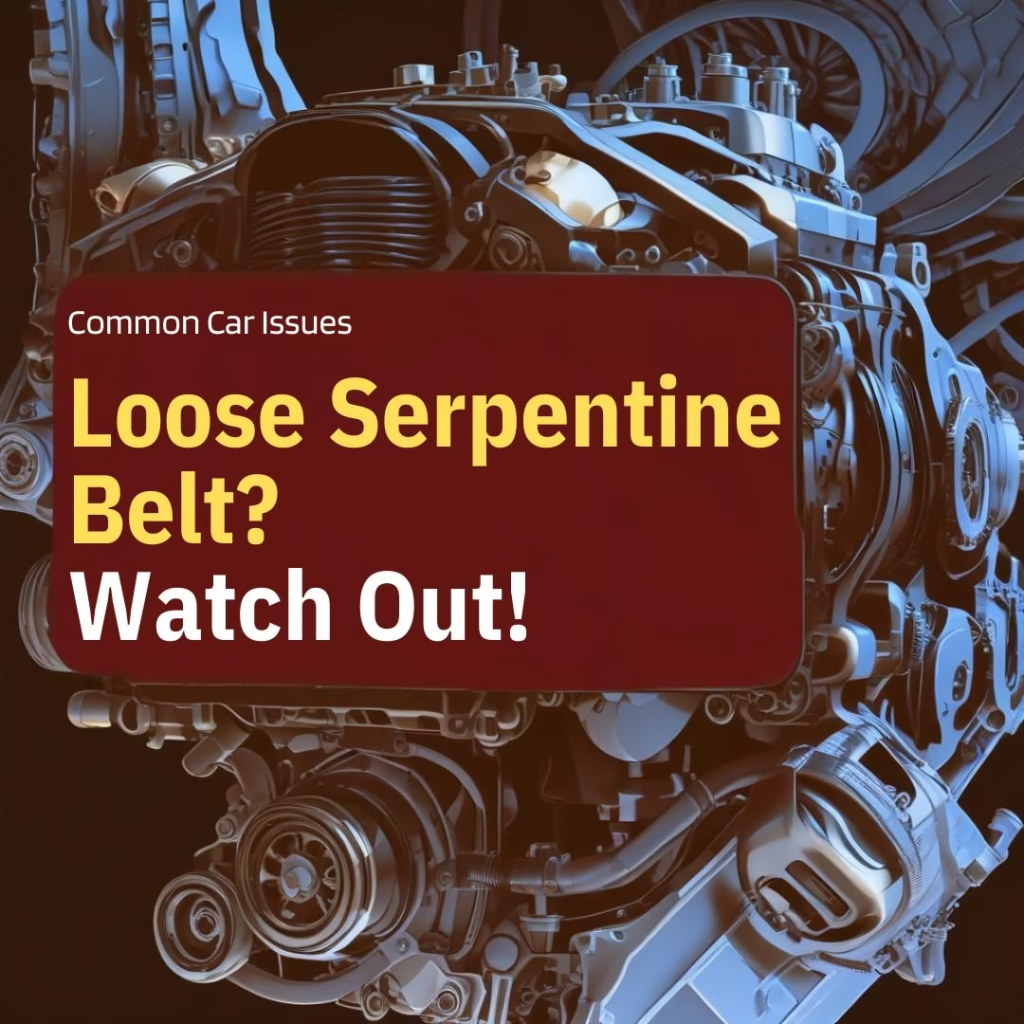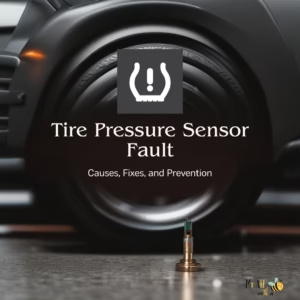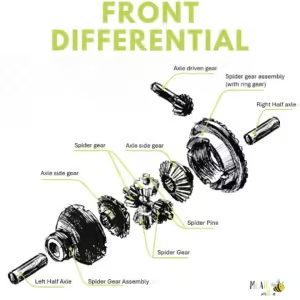A common saying in car repair is, “If it ain’t broke, don’t fix it!” While it may seem illogical to replace a functioning part, doing so can be more cost-effective in the long run. This is especially true for the serpentine belt, a crucial component of your vehicle. If it breaks, you might find yourself stranded on the road waiting for a tow truck. We recommend replacing it proactively to avoid costly repairs. A loose serpentine belt can cause serious issues, impacting everything from the alternator to power steering. In this post, we’ll discuss the problems associated with a loose serpentine belt, the symptoms to watch for, and how to address the issue.
Understanding the Serpentine Belt
What Is a Serpentine Belt?
The serpentine belt is a continuous rubber belt that powers essential components in your vehicle, connecting multiple parts like the alternator, air conditioning compressor, and power steering pump for efficient operation. Often referred to as a drive belt, fan belt, or accessory belt, it replaces older systems that use multiple belts to connect the engine to various accessories. Modern vehicles typically utilize one serpentine belt that winds through several pulleys to power all accessories.
While this design is efficient and reliable, a broken serpentine belt can lead to significant issues. You’ll lose power steering, the air conditioner will stop working, the battery may eventually die, and the engine could overheat. Additionally, a broken belt might damage the engine accessories it controls. This is why it’s crucial to replace your serpentine belt on a regular schedule.
Serpentine Belt vs. Timing Belt
Don’t confuse the serpentine belt with the timing belt. The timing belt is located inside the engine and keeps the crankshaft and camshaft synchronized. It ensures that the engine’s intake and exhaust valves open and close in sync with the pistons, allowing for smooth engine operation. In contrast, the serpentine belt powers the engine accessories by connecting the crankshaft to various components outside the engine. You can easily distinguish between the two by their grooves: a timing belt features horizontal “teeth” designed to fit the cogwheels of the crankshaft and camshaft, while a serpentine belt has vertical V-shaped grooves.
Drivers often need to replace these belts around the same time, so it’s a good idea to check with your mechanic or consult your owner’s manual to determine if your timing belt also needs replacement.
Components Driven by the Serpentine Belt
Key components powered by the serpentine belt include:
- Alternator: This component generates electrical power for the vehicle, charging the battery and powering electrical systems while the engine runs.
- Water Pump: Responsible for circulating coolant throughout the engine, the water pump helps maintain optimal operating temperatures and prevents overheating.
- Power Steering Pump: This pump assists in steering by providing hydraulic pressure, making it easier to maneuver the vehicle.
- Air Conditioning Compressor: The compressor is crucial for the air conditioning system, compressing refrigerant and allowing for effective cooling within the cabin.
When the belt is loose, these systems don’t function properly, leading to noticeable issues.
Problems associated when Serpentine Belt is Loose
Squeaking or Squealing Noises
One of the earliest signs of a loose serpentine belt is a squeaking or squealing sound. This noise occurs when the belt fails to grip the pulleys tightly, causing it to slip. If you hear this sound, it’s a warning that the belt may need adjustment or replacement.
Battery Warning Light
A loose serpentine belt can also affect the alternator, which is responsible for charging your car’s battery. If the belt isn’t functioning properly, it may trigger the battery warning light on your dashboard, indicating that your battery isn’t receiving adequate power.
Overheating Engine
The serpentine belt drives the water pump, which is crucial for cooling the engine. If the belt becomes loose, it can disrupt the flow of coolant, leading to engine overheating. This is a serious issue that requires immediate attention to prevent potential engine damage.
Power Steering Issues
A loose serpentine belt can create difficulties in steering because it affects the power steering pump. You may notice that the steering wheel feels stiff or unresponsive, making it harder to maneuver the vehicle. This problem not only affects driving comfort but can also pose safety risks.
Consequences of Ignoring a Loose Serpentine Belt
Damage to Engine Components
Neglecting issues caused by a loose serpentine belt can result in significant damage to essential engine components such as the alternator, water pump, and power steering pump. For instance, if the belt slips or wears down, it may strain these parts, leading to premature failure. The cost of repairing or replacing damaged components can be substantial, not to mention the inconvenience of being without your vehicle during repairs. Proactively addressing serpentine belt issues can save you from these expensive repairs and keep your vehicle running smoothly.
Complete Belt Failure
If the serpentine belt fails completely while you’re driving, the consequences can be severe. You may suddenly lose power to critical systems, leading to potential engine overheating as the water pump ceases to function. Additionally, the loss of power steering can make the vehicle difficult to control, increasing the risk of an accident. This sudden failure not only endangers your safety but can also lead to further damage to the engine and other components, compounding repair costs. Regular maintenance and timely replacement of the serpentine belt are essential to prevent such dangerous situations.
Diagnosing a Loose Serpentine Belt
Visual Inspection
Conducting a visual inspection of the serpentine belt is an important first step in assessing its condition. Look for visible signs of wear and tear, such as fraying edges, cracks, or any signs of looseness. A belt that is worn out often appears shiny or glazed on its underside, indicating that it may not be gripping the pulleys effectively. Additionally, check for any signs of uneven wear or surface damage, as these can signal potential issues that need to be addressed.
Tension Tests
To evaluate the belt’s tension, press down on the belt with your fingers. It should have some flexibility or “give,” but it shouldn’t feel excessively loose. If it does, this could indicate that the belt needs adjustment or replacement. For a more accurate assessment, consider using a belt tension gauge. This tool provides precise measurements of the belt’s tension, helping you determine whether it falls within the manufacturer’s specified range. Regular tension checks can help ensure optimal performance and longevity of the serpentine belt.
Solutions and Preventive Measures
Adjusting the Tension
If you find that the serpentine belt is loose, it’s essential to adjust the tension using the tensioner mechanism. This adjustment helps ensure that the belt maintains proper grip on the pulleys, promoting efficient operation of your vehicle’s components and preventing problems when the serpentine belt is loose. Always refer to your vehicle’s owner’s manual for specific instructions on how to make these adjustments correctly. If you’re unsure or uncomfortable performing this task, it’s best to consult a professional mechanic who can ensure it’s done safely and effectively.
Replacing the Belt
If your inspection reveals significant wear, such as cracks, fraying, or glazing, it’s crucial to replace the serpentine belt immediately. Continuing to use a damaged belt can lead to further complications and costly repairs. When replacing the belt, choose a high-quality serpentine belt that is specifically designed for your car model. This ensures compatibility and optimal performance, helping to extend the life of your vehicle’s components.
Regular Maintenance
To prevent future issues with the serpentine belt, incorporate regular inspections into your routine maintenance schedule. It’s advisable to check the belt every 30,000 to 50,000 miles, or as recommended by your vehicle manufacturer. During these inspections, look for any signs of wear and ensure that the tension is within the specified range. By being proactive about maintenance, you can catch potential problems early and keep your vehicle running smoothly.
Conclusion
In conclusion, paying attention to the serpentine belt is essential for the reliable operation of your vehicle. Although the adage “If it ain’t broke, don’t fix it” may suggest that you can ignore a functioning part, proactively replacing a worn or loose serpentine belt can save you from costly repairs and unexpected breakdowns. This critical component powers vital systems like the alternator, water pump, and power steering. Ignoring potential problems when the serpentine belt is loose can lead to serious issues, so regular inspections and maintenance are key to preventing complications. Stay ahead by ensuring your vehicle remains safe and efficient on the road with the timely care of your serpentine belt!
FAQs
- Sounds produced problems when serpentine belt is loose?
It often makes squeaking or squealing noises while the engine runs. - What causes a serpentine belt to become loose?
Wear, aging, or a faulty tensioner can cause it to lose tension. - Can you drive with a loose serpentine belt?
Driving with a loose belt is risky and can lead to severe engine damage. - How do I check if my serpentine belt is loose?
Perform a visual inspection or use a belt tension gauge to check for proper tension. - What happens if the serpentine belt breaks?
Your car may lose power steering, overheat, and stop charging the battery. - Can I tighten a loose serpentine belt myself?
Yes, but only if your vehicle has a manual tensioner. Many modern cars use automatic tensioners. - How often should I replace my serpentine belt?
Replace it every 30,000 to 50,000 miles or as per your car’s manual. - What tools do I need to fix a loose serpentine belt?
You’ll need a wrench or socket set and possibly a belt tension gauge. - Can a loose serpentine belt cause overheating?
Yes, it can affect the water pump, leading to engine overheating. - What’s the cost of replacing a serpentine belt?
Replacement costs range from $50 to $200, depending on the car model and labor fees.
If you like this post, you may also like
Thanks for reading, for more interesting articles, visit our homepage.









Pingback: Why Is My Car Shaking When Driving or Braking?